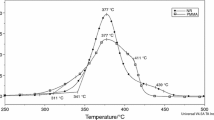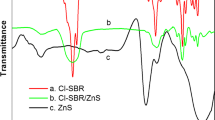Abstract
The thermal decomposition behavior of styrene-butadiene rubber was studied using a system equipped with thermogravimetric analysis, differential thermal analysis, Fourier transform infrared spectroscopy, and mass spectroscopy. Two different experiments were conducted. From these experiments, thermogravimetric analysis results indicated a mass loss of 58 % in the temperature range of ~290–480 °C and a mass loss of 39 % in the temperature range beyond 600 °C. Scanning electron microscopy coupled with energy-dispersive X-ray spectroscopy confirmed the presence of oxides, even at 1,000 °C, accounting for the Zn, Mg, Al, Si, and Ca in the original sample.







Similar content being viewed by others
References
Brown HR, Bouvard JL, Oglesby D, Marin E, Francis D, Antonyraj A, Toghiani H, Wang PT, Horstemeyer MF. Mechanical behavior and fatigue studies of rubber components used in tracked vehicles. http://www.dtic.mil/cgi-bin/GetTRDoc?Location=U2&doc=GetTRDoc.pdf&AD=ADA530663.
Rybinski P, Janowsk G, Kucharska J, Jastrzabek A. Influence of surface modification on thermal stability and flammability of cross-linked rubbers. J Therm Anal Calorim. 2010;100:1037–44.
Mati M, Mitra S, Bhowmiek AK. Effect of nanoclays on high and low temperature degradation of fluoroelastomers. Polym Degrad Stab. 2008;93:188–200.
Janowska T, Rybinski O, Jantas R. Effect of the modification of silica on thermal properties and flammability of cross-linked butadiene-acrylonitrile rubbers. J Therm Anal Calorim. 2007;87:511–7.
Radell EA, Strutz HC. Identification of acrylate and methacrylate polymers by gas chromatography. Anal Chem. 1959;31:1890–1.
Lehrle RS, Robb JC. Direct examination of the degradation of high polymers by gas chromatography. Nature. 1959;183:1671.
Hackathorn MJ, Brock MJ. Determination of head–head and tail–tail structures in polyisoprenes. Rubber Chem Technol. 1972;45:1295–302.
Lattimer RP, Harris RE, Rhee CK, Schulten HR. Identification of organic compounds in uncured rubber compounds using mass spectrometry. Rubber Chem Technol. 1988;61:639–57.
Schulten HR, Plage B, Lattimer RP. Pyrolysis-field ionization mass spectrometry of rubber vulcanizates. Rubber Chem Technol. 1989;62:698–708.
Bach J, Braun D, Mueller I, Wendorff JH. Aging of rubber modified thermoplastics and elastomers. Angew Makromol Chem. 1985;137:21–34.
Matheson MJ, Wampler TP, Simonsick WJ. The effect of carbon black filling on the pyrolysis behavior of natural and synthetic rubber. Rubber World. 1996;213:14–6.
Ghebremeskel GN, Sekinger JK, Hoffpauir JL, Hendrix C. A study of the thermal degradation products of styrene-butadiene type rubber by pyrolysis/GC/MS. Rubber Chem Technol. 1996;69:874–84.
Chien JCW, Kiang JKY. Polymer reactions. X. Thermal pyrolysis of poly(isoprene). Eur Polymer J. 1979;15:1059–65.
Wang J, Pan Y, Fang Y, Wang Y. Determination of the rubber composition in styrene–butadiene latex by pyrolysis gas chromatography. Huaxue Shijie. 1985;26:177–9.
Lee YS, Lee W, Cho S, Kim H. Quantitative analysis of unknown compositions in ternary polymer blends: a model study on NR/SBR/BR system. J Anal Appl Pyro. 2007;78:85–94.
Choudhury NR, De P, Dutta NK. Thermal analysis of rubbers and rubbery materials. U.K.: Smithers Rapra Technology Ltd.; 2010. p. 546.
Antonyraj A, German RM, Wang PT, Horstemeyer MF. DSC analysis of Al6061 aluminum alloy powder by rapid solidification: effect of additives. J Therm Anal Calorim. 2010;100:361–6.
Mullens J. EGA—evolved gas analysis. In: Brown ME, editor. Handbook of thermal analysis and calorimetry, vol 1, Chapter 12. Amsterdam: Elsevier Science; 1998. p. 1509–46.
Macaione DP, Sacher RE, Singler, RE. Thermogravimetric characterization of elastomers and carbon-filled rubber composites for military applications. ASTM special technical publication. Compos Anal Thermograv. 1988;99759–69.
ASTM D297-93 e2, Standard test methods for rubber products-chemical analysis; 2002.
ASTM E1131-98, Standard test method for compositional analysis by thermogravimetry; 2003.
ASTM D6370-99, Standard test method for rubber-compositional analysis by thermogravimetry; 2003.
ASTM D3677-00, Standard test methods for rubber-identification by infrared spectrophotometry; 2004.
ASTM E1641-07, Standard test method for decomposition kinetics by thermogravimetry; 2007.
ASTM D5805-00, Standard test method for rubber from synthetic sources-carbon black in masterbatches; 2009.
Sawyer L, Grubb DT, Meyers GF. Polymer microscopy, XIV. 3rd ed. New York: Springer: 2008. p. 540.
Thomas EL. Structure of crystalline polymers, Hall IH, editor. London: Elsevier-Applied Science; 1984. p. 79.
Hobbs SY. Plastic polymer science and technology. Bayal MD, editor. New York: Wiley-Interscience; 1982. p. 239.
Grubb DT. Developments crystalline polymers, Bassett DC, editor. London: Applied Science; 1982, p. 1.
Hayat MA. Positive staining for electron microscopy. New York: Van Nostrand Reinhold; 1975.
Hayat M. Principles and techniques of electron microscopy-biological applications. 3rd ed. Boca Raton: CRC Press; 1989.
Lewis PR, Knight DP, editors. Staining methods for sectioned material. Amsterdam: North Holland-American Elsevier; 1977.
Berrisford DJ, Bolm C, Sharpless KB. Ligand-accelerated catalysis. Angewandte Chemie International Edition. 1995;34:1059–70.
Sacher RE, Macaione DP, Singler RE, Thermal analysis and characterization of elastomers and carbon black filler rubber composites for army applications” Army materials and mechanics research center wateron, Massachutts, Final report # AMMRC TR 1985;85–4, http://www.stormingmedia.us/52/5280/A528061.html.
Eilhannkwon K, Castaldi MJ. Fundamental understanding of the thermal degradation mechanisms of waste tires and their air pollutant generation in a N2 atmosphere. Environ Sci Technol. 2009;43:5996–6002.
Williams PT, Besler B, Taylor DT. The batch pyrolysis of tire waste–fuel properties of the derived pyrolytic oil and overall plant economics. Proc Instn Mech Eng. 1993;207:55–63.
Kaminsky W, Tossler H. Olefins from wastes. Chem Tech. 1992;22:108–13.
Wey MY, Liou BH, Wu SY, Zhang CH. The autothermal pyrolysis of waste tires. J Air Waste Manage Assoc. 1995;45:855–63.
Acknowledgements
This material is based upon work supported by the U.S. Army TACOM Life Cycle Command under Contract No. W56HZV-08-C-0236, through a subcontract with Mississippi State University, and was performed for the Simulation Based Reliability and Safety (SimBRS) research program. Any opinions, findings, conclusions, or recommendations expressed in this material are those of the author(s) and do not necessarily reflect the views of the U.S. Army TACOM Life Cycle Command. The authors would also like to acknowledge the support of the Center for Advanced Vehicular Systems (CAVS) at Mississippi State University (MSU).
Author information
Authors and Affiliations
Corresponding author
Rights and permissions
About this article
Cite this article
Arockiasamy, A., Toghiani, H., Oglesby, D. et al. TG–DSC–FTIR–MS study of gaseous compounds evolved during thermal decomposition of styrene-butadiene rubber. J Therm Anal Calorim 111, 535–542 (2013). https://doi.org/10.1007/s10973-012-2559-0
Received:
Accepted:
Published:
Issue Date:
DOI: https://doi.org/10.1007/s10973-012-2559-0




